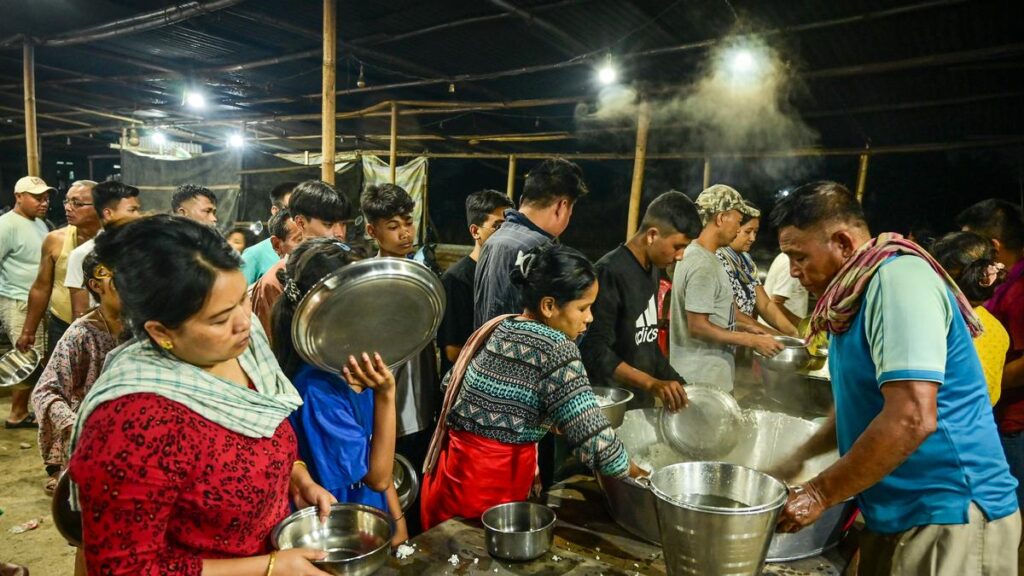
‘Official estimates account only for those in registered relief camps, omitting unregistered individuals living with relatives, in temporary shelters, or displaced across multiple locations’
| Photo Credit: Getty Images
The India-Myanmar borderlands remain a data-deficient region despite their long history of armed conflict, displacement, and humanitarian crises. The complexity of the Manipur conflict, along with restricted access and adverse security conditions, has led to huge gaps in documenting humanitarian needs. In Manipur, the lack of reliable data obscures the true scale of vulnerabilities and devastation. Misinformation and disinformation further cloud an empirical understanding of the conflict, making it crucial to highlight the serious implications of these information gaps for affected populations. Recent estimates indicate that approximately 58,000 individuals have been forcibly displaced and are living in hundreds of “relief camps” in the Valley and Hill districts. Forced displacement is dynamic, and data collection remains fragmented. In addition, nearly 12,000 people fled to Mizoram at the peak of the conflict, while approximately 7,000 people sought refuge in Nagaland, Assam and Meghalaya.
A zone of ‘the unknown’
A critical issue since the onset of the conflict has been the breakdown in the chain of accurate humanitarian information due to the physical separation of the Meitei and Kuki-Zomi communities. Official estimates account only for those in registered relief camps, omitting unregistered individuals living with relatives, in temporary shelters, or displaced across multiple locations. Those who have left the State due to conflict-related circumstances are also unaccounted for. A significant but unrecognised category of affected individuals includes thousands of Manipuri youth who have left in search of better education and livelihood. Another overlooked group comprises those forced to seek medical care outside the State. The conflict has drastically altered health-care-seeking behaviour in Kuki-Zomi-dominated hill districts, with major tertiary health-care institutions in Imphal still inaccessible. Consequently, individuals must take circuitous routes through Mizoram (for those in Churachandpur, Chandel, and Tengnoupal) or Nagaland (for those in Kangpokpi).
Medical problems
Meanwhile, displaced populations in the Imphal Valley struggle with increasing out-of-pocket expenses for medical treatment, often leading to a discontinuation of care. Manipur’s health-care system, already marked by disparities between the Valley and Hill districts, has deteriorated. The absence of systematic documentation results in underreported cases of mortality, malnutrition, and disease outbreaks. Threats to medical facilities and blockades on essential medicines also remain largely unrecorded. Mortality due to delayed medical access has become an issue, with average journey times for patients from Churachandpur between 17 hours and 24 hours. Some cases documented by a humanitarian data platform highlight the severity of the situation. On May 29, 2023, a 63-year-old displaced person died of cardio-respiratory failure and chronic kidney disease in Kangpokpi district due to a lack of dialysis facilities. In June 2023, a mother died from excessive bleeding after childbirth in a relief camp in Churachandpur district. At the same time, a one-month-old infant was rescued from a relief camp in Bishnupur district after being abandoned by her parents who were unable to care for her. On September 22, 2023, a one-year-old girl died from pneumonia in a relief camp in Churachandpur district.
A recent local media report has documented at least 13 deaths in relief camps in the Valley, including suicides. A study by doctors from the Regional Institute of Medical Sciences (RIMS) in displaced persons camps in Imphal East District found that 65.8% of respondents suffer from post-traumatic stress disorder, while 24.8% experience moderate anxiety and 15.2% have severe anxiety. In Churachandpur district, an ongoing suicide study by a community research institution (NEST Suicide Survey) recorded at least three cases, including a 70-year-old displaced man, who struggled to adapt to camp life after losing his previous livelihood.
It has been more than two years since the first relief camps were formed, yet the basic humanitarian needs of food, water and shelter, remain largely unmet. Dwindling resources, donor fatigue, and conflict-induced inflation have worsened conditions for displaced populations on both sides of the ethnic divide. With over 22,000 children still living in camps, the situation is especially dire, severely impacting education. Unsanitary living conditions, daily water shortages, a lack of access to nutritious food, and the absence of income sources are compounding the crisis.
Measures to take
Although violence has decreased in terms of casualties and conflict incidents along inter-district boundaries, forced displacement remains a peripheral issue. The humanitarian crisis in relief camps persists, with a high risk of outcomes worsening as the situation extends into the third year. Mitigating measures are needed. The first is enhancing external cross-cutting humanitarian support by external agencies (including corporate social responsibility entities) to vulnerable populations. The second is augmenting the supplies of clean drinking water, which is a serious issue as a significant portion of household incomes is being used to get water from private sources. The third is creating “humanitarian corridors” that enable the emergency evacuation of serious patients from the hill districts through Imphal airport. The fourth is the restoration of supply chains for the transport of essential commodities, food items and medical supplies from the valley into the hill districts and vice-versa through neutral communities, thereby mitigating inflationary pressures locally.
Samrat Sinha is Professor, Jindal Global Law School (JGLS), Visiting Researcher, Peace Centre Nagaland and Research Advisor (Humanitarian Data) NEST Research Department-Manipur
Published – February 20, 2025 12:08 am IST
Source:https://www.thehindu.com/opinion/op-ed/talk-about-manipurs-worsening-humanitarian-crisis/article69239645.ece

